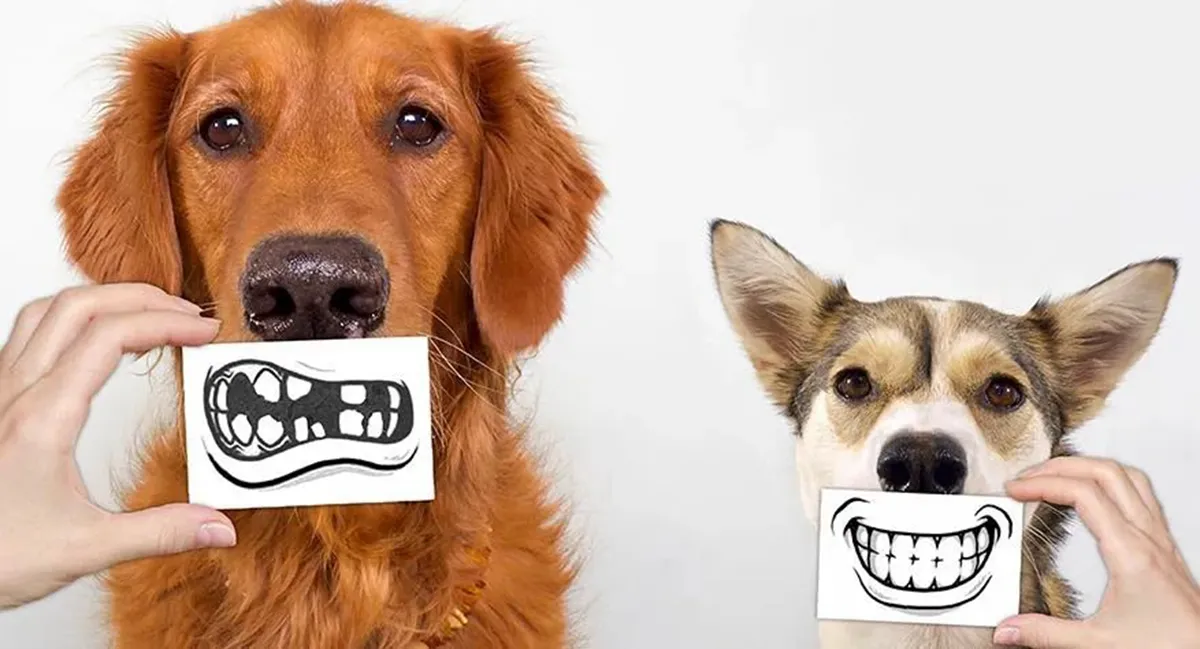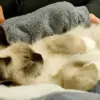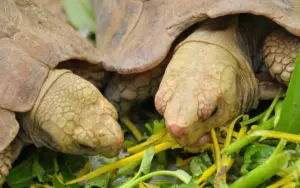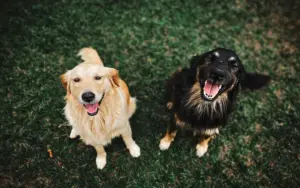There’s a persistent urban legend among dog owners: „Feeding dry kibble helps maintain dental health!“ This belief has become so widespread that even many owners who advocate natural diets still add dry food like a nutritional supplement – not for balanced nutrition, but specifically for „teeth whitening.“
But does dry food truly clean teeth? Could it even replace brushing?
Table of Contents
Can Dry Food Clean Teeth?
In the early 20th century, some studies did suggest:
- Dogs eating exclusively dry kibble showed better oral health than those eating canned food or softened dry food.
A 1965 study also found:
- Dogs consuming mashed food developed more plaque and gum inflammation than those eating whole foods. The common-sense perception that crunchy kibble „scrapes“ teeth better than soft food seems logical.
So does that mean the legend is true?
Not so fast.
In 1996, scientists conducted a large-scale study observing 1,350 dogs across North America. Their findings revealed:
- No significant difference in tartar levels between dogs eating only dry food and those consuming non-dry-food diets.
This conclusion has been endorsed by numerous veterinary experts, who emphasize:
Dry food’s dental-cleaning effects are extremely limited.
The mechanical action of chewing hard kibble creates minimal friction against teeth surfaces. Moreover, starch residues from processed dry food may even accelerate plaque formation. Ultimately, regular tooth brushing remains the gold standard for canine dental care.
Even the 4th Edition of Small Animal Clinical Nutrition (published in 2000) states:
While soft foods do encourage plaque buildup, the common belief that „dry food cleans teeth“ is questionable.
Dry food shows little difference from wet food in promoting plaque or tartar formation.
Crunchy kibble shatters upon contact with teeth, offering negligible cleaning effects.
Multiple studies suggest:
- Chewing behavior(not food texture) plays a far greater role in reducing plaque and tartar.
- Relying solely on dry food to prevent gum disease or tartar is scientifically unsupported.
The Truth About Kibble
Statistics show 80-90% of U.S. pet dogs eat commercial dry food. If kibble truly supported dental health, most dogs would have pristine teeth.
Reality Check
Data from VCA Animal Hospitals, a leading U.S. veterinary chain, reveals:
- Dental disease is the #1 medical issue in pets.
- Over 80% of dogs aged 3+ suffer from some form of dental disease.
Kibble = Puffed Snacks
Dog kibble is essentially processed puffed food. If it cleaned teeth, humans could „brush“ their teeth by eating potato chips or shrimp crackers.
How wonderful that would be…
But truthfully, its only „benefit“ might be delaying cavities by two days compared to eating cream cake.
Brush Daily for Healthy Teeth
Even when dogs eat dry kibble — which seems „clean“ — tiny food particles stick to their teeth.
If not brushed away promptly, these residues become a feast for oral bacteria, forming plaque.
Here’s the timeline:
- Plaque forms within hours after eating.
- Within 24 hours, it hardens into tartar (calculus), which keeps accumulating.
Tartar irritates gums, causing:
🔴 Swelling and redness
🔴 Bleeding
🔴 Persistent bad breath
Over time, this leads to:
🦷 Loose teeth and tooth loss
🦷 Tooth root infections, which can create facial abscesses („rotting holes“)
🦷 Rare but deadly risks like sepsis
The Solution? Brush!
Daily brushing:
✅ Removes plaque before it hardens
✅ Prevents gum disease and pain
✅ Keeps your dog’s breath fresher
Let them enjoy every bite!
No magic kibble can replace a toothbrush.
Healthy teeth = Happy, hungry pup! 🐶🍖
How to Clean Your Dog’s Teeth
For Cooperative Dogs
- Hold their head gently and use a finger toothbrush or dog-specific toothbrush.
- Apply pet-safe toothpaste(never human toothpaste!).
- Brush in gentle circles, focusing on the outer surfaces of teeth (inner surfaces are less critical).
- No rinsing needed. A full session takes under 2 minutes.
For „Fussy“ Dogs
Step 1: Build Trust
- Let them taste pet toothpaste first (chicken or beef flavors work best!).
- Reward with praise or a treat.
Step 2: Gradual Introduction
- Start by rubbing their teeth and gums with a clean gauze-wrapped finger.
- Slowly transition to a finger brush or soft-bristled toothbrush.
Step 3: Focus on Problem Areas
- Front teeth (incisors/canines) are easier to clean.
- For back molars: Lift their lip gently and brush at a 45-degree angle.
Pro Tips
✅ Choose safe toothpaste: Avoid alcohol, xylitol, or titanium dioxide. Opt for veterinary-recommended brands.
✅ Timing matters: Brush when they’re calm, like after exercise.
✅ Reward consistently: Turn brushing into a positive ritual.
If All Else Fails
- Use dental chews or enzyme-based water additives as supplements.
- Schedule professional cleanings with your vet.
Patience wins!
Even 30 seconds of brushing daily can prevent costly dental issues. 🐾🦷
When Your Dog Hates Brushing (or Bites)
- Seek Professional Help
🔹 Trainer intervention: A certified dog trainer can address aggression and fear using positive reinforcement.
🔹 Vet check: Rule out dental pain causing the behavior. - Make „Brushing“ a Game
🔹 Smear pet-safe toothpaste on chew toys(e.g., Kong) – let them “brush” themselves while gnawing.
🔹 Use dental wipes as a less invasive alternative to brushes. - Dietary Adjustments (Consult Your Vet First!)
🔹 Reduce kibble carbs: High-carb diets fuel plaque bacteria. Opt for dental-formula kibble or balanced raw/fresh food.
🔹 Offer raw meaty bones(e.g., chicken necks): Gnawing scrapes plaque naturally. Never cook bones – they splinter!
But Don’t Rely on Diet Alone!
- Raw meat ≠ dental cure: Even wolves get tooth decay.
- Nutritional risks: Raw diets require expert balancing to avoid deficiencies.
- Bacterial hazards: Salmonella and E. coli risks for both pets and humans.
- Embrace Alternatives (Temporarily)
🔸 Water additives: Enzymatic formulas reduce plaque.
🔸 Dental gels: Apply to teeth weekly to soften tartar.
🔸 Professional cleanings: Essential for severe cases.
The Bottom Line 💡
Brushing is still the gold standard – even 2-3 times weekly makes a difference! Pair it with:
✅ Praise + high-value treats (e.g., freeze-dried liver)
✅ Patience: Start with 5-second sessions, gradually increase.
Would I brush my dog’s teeth? Absolutely – it’s cheaper than a $1,000 vet dental bill! 🐾💰









Add comment